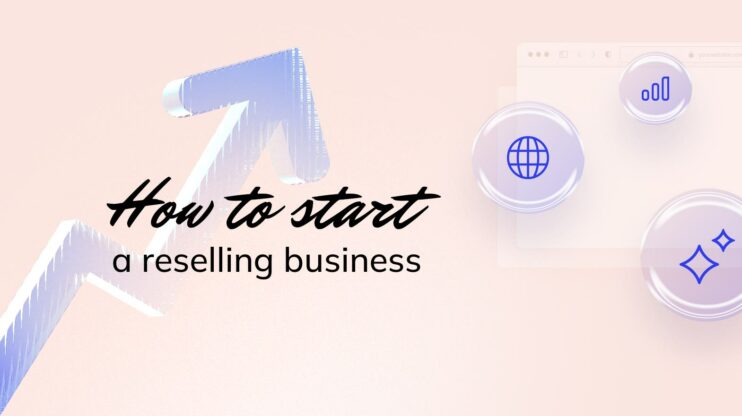Starting a business is one of the most rewarding (and let’s be honest, challenging) things you can do. You’ve got the idea, the drive, and maybe even a pinch of self-doubt. The road ahead is full of twists, turns, and probably a few potholes, but that’s all part of the ride.
The reality is that 79% of small businesses survive their first year, but more than half don’t make it to year five, and by year 10, 70% have closed up shop. Maybe it’s depressing, but these numbers aren’t a reason to give up—they’re a reminder of why planning and persistence matter so much. If you’re ready to stick with it, you’re already ahead of the pack.
The secret isn’t avoiding challenges—it’s turning them into opportunities. Success comes from building a plan you believe in and being flexible enough to adjust when life throws you a curveball. And trust me, it will. Every step you take, no matter how small, moves you closer to your goal.
In this article, I’ll walk you through the process of building your business, step by step: shaping your idea, creating a plan, launching with purpose, and scaling for growth. Whether you’re aiming for a side hustle or the next big thing, it all starts here.
Stage 1: Ideation and problem identification
Though not all businesses start with a great idea, yours can. But it’s not just about being creative—it’s about solving a real problem for your customers. In this stage, I advise you to focus on finding opportunities, testing your ideas, and making sure they match your skills, interests, and what the market needs.
Daniel Priestley, a successful entrepreneur, says that coming up with business ideas should be a thoughtful process. It’s about brainstorming many ideas, exploring them, and choosing the ones that work best.
By understanding the “why” behind your business, you build a strong foundation with a clear purpose. This helps you connect with customers and earn their trust.
Step 1: Generate/conceptualize your business idea
Every successful business starts with a simple question: what problem can I solve? If you’re brainstorming, start by looking at the everyday challenges people face and think about how your skills or passions could make life easier. Write down the ideas that excite you—the ones you’d love to wake up every day and work on.
If you’ve already got a few ideas, fantastic! Now, focus on solving a specific problem for your target audience. Once you’ve fine-tuned your idea, give it a reality check. Ask yourself:
- Feasibility: Do I have the skills or resources to make this happen?
- Profitability: Is there enough demand for this to be sustainable?
- Usefulness: What value will it bring to people?
- Uniqueness: How does my idea stand out from the competition?
Don’t be afraid to combine elements from different ideas to create something stronger. The magic often lies in mixing and matching. Think about blending a cloud storage platform with an AI-powered file organization tool—it could result in a system that automatically categorizes files, saving users from endless scrolling.
No matter how cool an idea seems, if it doesn’t solve a real problem, it’s not going to work. Trust me, I learned this the hard way. Back in 2016, I was fired up about launching what we thought was a great idea—a sticker marketplace. Our small team was convinced it would boom, so we invested $500,000 without really asking: Who needs this? What problem are we solving?
We spent the resources of 25 people and 12 months on the projects, but it felt flat leaving a big lesson behind–always start with the problem. If you’re offering a solution for a real pain point, you’re already halfway to building something valuable.
Step 2: Conduct a SWOT analysis
A SWOT analysis is a simple but powerful tool to give your business idea a clear picture. This analysis is used to identify strengths, weaknesses, opportunities, and threats for your business. Think of it as putting your idea under a microscope to spot its strengths, weaknesses, opportunities, and threats.
Start with your strengths
Identify what makes your idea stand out. Is it cutting-edge technology, a fresh perspective, or a special skill you bring to the table? Maybe you are great at developing user-friendly apps or solving complex tech problems. Write down anything that gives you an edge.
Get real about your weaknesses
No one has it all figured out. The important thing is to pinpoint where you might need a hand. Maybe you are not sure how to market your product or you are running low on funds to scale. Recognizing these challenges early means you can plan and find smart solutions before they slow you down.
Spot your opportunities
The next part is my favorite; going out in the world and finding new opportunities, and new gaps in existing businesses that bring value to the consumer. You can ask yourself: What’s happening in the world that you can tap into? Maybe remote work is booming, and your idea for a collaborative project management tool is more relevant than ever. Look for trends or gaps in the market that align with your idea.
Don’t ignore the threats
Analyzing the threats is where you identify the challenges that could throw your plans off track. Think of it like spotting potholes on a road trip; the earlier you see them, the smoother your ride. For example, when we were growing 10Web, an AI-powered Website Builder, we knew the market was flooded with DIY platforms. The threat was clear: how do we stand out in a crowded space?
Our answer was to lean hard into automation—offering features like one-click WordPress migration and AI tools that saved users hours of work. By planning for the competition, we turned a potential threat into our advantage. The learning is that anticipating risks isn’t about paranoia—it’s about finding your next big opportunity before someone else does.
Step 3: Validate your idea through research
Next comes putting your idea to the test. Validation means seeing if your idea stands up in the real world.
Study the competition
Take a good look at what others in your space are doing. Identify their strengths and where they fall short. Check out their products, pricing, and customer feedback. The goal isn’t to copy—it’s to find ways to improve and stand out. For instance, if you’re creating a subscription box, figure out what current boxes lack and deliver something better.
Talk to potential customers
You’ve got to step out of your bubble and connect with the people who’ll actually use your product. Start by asking your target audience what they need, if they’d buy your solution, and what they’d tweak. It’s not just market research—it’s a chance to make users feel like part of the process/product. When you ask for their input, you’re showing you value their opinion, and the feedback you get will be honest, raw, and incredibly useful.
Keep it casual—whether it’s a quick chat, a survey, or a focus group. Let’s say, you’re building an app for busy parents, ask them how they manage the daily chaos. Trust me, they’ll tell you exactly what they need—and maybe a few things you hadn’t even thought of.
Track industry trends
Business is always evolving, and you need to keep up. Many customers are shifting toward sustainability. And new tech is reshaping your industry. Spot those trends and use them to refine your idea. Say you’re in tech—you might notice businesses are struggling with data organization as remote work grows, sparking an idea for an AI-powered tool that automatically organizes files and streamlines collaboration. Insights like this can shape your offerings to meet emerging needs.
Test with a Minimum Viable Product (MVP)
An MVP is your product’s first test release—it just needs to prove the concept. Build a simple version showcasing the core value and test it with a small, focused group of potential users who genuinely need what you’re offering. The test size depends on your resources and goals, but keep it manageable. You don’t want to spend a ton of money at this stage.
Offer it for free or at a low cost to gather honest, actionable feedback. Financing can come from savings, a small pre-seed round, or teaming up with a co-founder to share the costs. The insights from this test will show you what works, what needs fixing, and what users are willing to pay for, helping you fine-tune before scaling up.
Stage 2: Building your business foundation
You’ve tested your idea and the MVP with real users; now you know you’re onto something. What you’re building solves a real problem and adds value to people’s lives—time to level up. This is where you lay the groundwork to turn your idea into a real business.
Make it official: register your business, get your finances in order, and create a brand that truly connects with your audience. Then, set up systems to keep everything running—think operations, tools, and processes. It might feel overwhelming, but don’t worry—we’ll break it all down and tackle it step by step. Let’s get to work!
Step 1: Choose your business structure and register your business
Choosing the right legal structure isn’t just a checkbox; it shapes how you’ll manage day-to-day operations, handle taxes, and navigate liability.
In the early stages, founders must be hands-on with every decision, including setting up the business’s foundation. I’ve learned that deeply understanding your startup’s framework helps you identify bottlenecks and build something scalable.
Think of it as the startup lifecycle: you begin by shaping the vision, hiring your first team, and putting the legal and operational groundwork in place. These early steps set the tone for everything else—so take the time to get them right.
Here’s a quick breakdown of common business structures you can go with:
- Sole Proprietorship: This is the simplest option if you’re running things solo. It’s easy to set up but keep in mind that your assets (like your home or car) aren’t protected if the business runs into trouble.
- Limited Liability Company (LLC): A popular choice for small businesses. It gives you the best of both worlds—personal asset protection and flexible taxes—while being relatively easy to set up.
- Corporation: If you’re planning for big growth, raising funds from investors, or bringing on shareholders, a corporation is the way to go. But be prepared for more paperwork and formalities.
Once you’ve decided on your business structure, it’s time to make things official (yes, it’s paperwork time, but trust me, the future-you will thank you):
- Register your business name: Pick something unique that reflects your brand’s identity. Not sure where to start? Tools like 10Web’s Business Name Generator can help spark ideas and ensure your name stands out.
- Get your licenses and permits: Depending on your location and industry, you might need specific approvals to open your doors—think health permits, business licenses, or zoning clearances.
- Apply for an EIN (Employer Identification Number): This is like your business’s Social Security number. It’s essential for handling taxes, hiring employees, and opening a business bank account.
Sure, it’s not the flashiest part of starting a business, but getting the legal details locked in now saves you from headaches later.
Step 2: Set up your finances
Money is what keeps your business alive. Even if you’re starting small, there are some financial requirements you need to check.
Start by opening a business bank account—this one’s non-negotiable. Separating your personal and business finances keeps things cleaner and more professional. Then, tackle bookkeeping to stay on top of your cash flow. Tools like QuickBooks, FreshBooks, or Wave are super user-friendly and help you track income, expenses, and invoices without needing to be a math wizard. A system like this gives you a clear picture of your finances so you can make smarter decisions.
If you need extra funds to kickstart your journey, there are many paths to consider. Bootstrapping with your own savings is a straightforward option, though it comes with risks. Small business loans—like SBA programs or local bank loans—offer a structured approach. But investors could be the way to go if you’re dreaming big and need more firepower.
As someone who invests in Armenian startups through Big Story VC, I’ve seen how the right backing can transform a bold idea into a global business. In the U.S., there’s a vibrant community of angel investors, such as Ron Conway, Naval Ravikant, and venture capitalists, such as Andreessen Horowitz (a16z), who’ve supported countless success stories. The key? Crafting a compelling pitch that not only showcases your idea’s potential but also demonstrates your commitment to making it a reality.
Always keep in mind that the best investors aren’t just funding—they’re partners who help you scale and succeed.
Step 3: Build your brand identity
Your brand isn’t just a logo or a catchy name—it’s the story that makes people remember you and trust what you offer. Start with a name that’s easy to remember and reflects your mission. A strong brand identity ties everything together, from visuals to messaging, creating a consistent experience for your audience.
Tools like the Business Name Generator by 10Web can make this process easier. It’s free and helps you craft a cohesive identity. By entering your business type, it generates not just the perfect name but also logo options and domain ideas, so you can hit the ground running with a polished brand.
Remember, your brand is what sets you apart. It’s how you connect with your audience on a deeper level, building loyalty and recognition over time. Take the time to get it right—it’s worth it.

Looking to sell online?
Create your custom online store in minutes with 10Web AI Ecommerce Website Builder and take your business online.
Stage 3: Execution and launch
Execution and launch are the moments when your dream steps out of your head and into the world as a living, breathing entity. I remember all the excitement of the first time we launched anything, even a small feature of an existing product. It is an electric mix of excitement and terror. Excitement because you have built something valuable. Terror because…well, what if nobody cares or it doesn’t work?
This stage is about more than just the launch day. It’s about taking thoughtful, confident steps to set up your operations, craft a brand that sticks with people, and put your product into the hands of those who need it most.
Done right, this is where you build not just a foundation for growth, but a connection with your customers. It’s their trust and belief in your vision that turns a product into a movement. So, embrace the mix of excitement and fear—it means you’re doing something worthwhile. And remember, it’s not just about launching; it’s about listening, learning, and continuously making your idea better.
Step 1: Set up your business operations
Getting your business operations in order from the start is essential. Michael Gerber, in The E-Myth Revisited, says, “Small businesses thrive when they rely on systems, not just the constant hustle of the owner.” The idea is to build a setup that runs like clockwork so you can focus on growth instead of being stuck in the daily grind.
Step 2: Invest in tools and build the engine of your business
Once your business is officially registered, it’s time to set up systems that keep everything running. Accounting software helps you manage finances, project management tools ensure tasks stay on schedule, and a CRM platform keeps customer relationships organized. These tools aren’t just for big companies—they’re your secret weapon for staying efficient and delivering a great customer experience.
Think of this as building the engine of your business. With these tools in place, you’ll reduce stress, avoid bottlenecks, and have a solid foundation to scale confidently when the time comes.
Step 3: Create a marketing plan
You don’t need a big, flashy campaign right away, but you do need a strategy to get the word out. Start with the basics, like a simple, professional website. Tools like 10Web’s AI Website Builder make it easy to create a clean, functional site that tells your story and showcases your offerings. With just a few clicks, you can have a polished digital home base up and running.
Here’s how to do it:
- Visit 10Web.io and click Generate Your Website to kick things off.
- Choose the AI-powered website option to let the AI handle the initial setup and design, saving you time and effort.
- Select a category that matches your business, whether it’s a bakery, a consulting service, or a creative studio. This ensures the website’s structure and features are tailored to your needs.
- Provide a brief description of your business, including details like what you offer, who your audience is, or your brand’s vibe. The AI will use this info to craft relevant content and design elements.
- Let the AI build your website. Once it’s ready, click Next to move forward.
- Pick a color scheme that reflects your brand’s personality and click Generate to apply it.
- Customize your website using 10Web’s drag-and-drop editor. You can easily tweak layouts, upload photos, add service descriptions, and include a contact form to help customers reach out.
Your website doesn’t need to be complicated—it just needs to work. By starting with 10Web, you’ll have a professional site that’s both polished and functional.
Here is a genuine opinion of a 10Web customer.
With features like AI-driven page customization, seamless integration of customer insights and payment systems, 10Web provided the tools I needed to create a visually stunning ecommerce store with ease.
Don’t stop there—tell your story. Share what inspired you to start this journey and what makes your business unique. People connect with authenticity, so let your personality shine through. A heartfelt origin story is far more compelling than a hard sales pitch and can be the key to earning trust and building loyal customers.
Step 4: Launch your product or service
It’s the go time! Start with a soft launch—share your product or service with a smaller group of early adopters. I’ve done this, and trust me, their feedback is gold. They’ll help you catch issues and refine things before you roll out to the masses.
When you’re ready for the big launch, make it a moment. Create a buzz with limited-time offers, discounts, or collaborations that get people excited. Social media and ads can be your megaphone—don’t hold back.
Stay tuned into your customers’ reactions. Be ready to adjust and keep the conversation going. Post-launch support isn’t just nice—it’s how you turn curious buyers into loyal fans. This is your big debut, so own it! You’ve got this.
Stage 4: Grow and scale your business
It’s time to grow. For me, this stage always feels like planting seeds and watching them flourish—it’s about reaching and retaining more customers and improving over time.
Start with smart, simple marketing. Social media ads, email campaigns, or useful content can work wonders if they genuinely connect with your audience. I’m a big fan of using data to keep it personal—nobody likes one-size-fits-all offers.
Collaboration is another secret weapon. Teaming up with complementary businesses or running referral programs can bring in new faces and build trust faster than going solo. Growth doesn’t have to be overwhelming—just focus on the strategies that work and build from there.
Step 2: Enhance your products and services
Growth isn’t just about getting more customers—it’s about giving them more of what they want. I’ve learned the best ideas often come straight from the people you’re already serving. Talk to your customers. Ask them what they’re missing or how you can make their experience better.
Once you have an idea, don’t dive in headfirst. Test it out with a small group first. Fine-tune as you go, and you’ll create something that really hits the mark.
Here’s what I’ve learned from my own journey: success often feels like it happened “overnight,” but in reality, it’s years of preparation meeting the right moment.
Take Krisp, for example. Before the pandemic, it was already a solid noise-cancelation solution. But when the world suddenly switched to working from home, the demand exploded. Parents on Zoom calls with kids screaming in the background. Professionals struggling in noisy home offices. Krisp was ready to save the day because we had spent years building and perfecting it. And the company grew 10 times in 2 years.
The same thing happened with 10Web. When ChatGPT launched and everyone became fascinated with AI, the media and users started searching for the next big AI tool. 10Web had already spent years innovating, using AI to make website building faster and easier. We were prepared, and the spotlight found us.
The takeaway is that success starts with solving a problem and committing to it. Prepare for years, and when the moment comes—when the world is ready—you’ll be ready too. You can either hope for luck or work for it, so build something valuable and stay the course.
Step 3: Keep your customers happy
Keeping your customers happy is the secret sauce to growth. Staying in touch goes a long way, whether it’s a quick follow-up email, a thank-you message, or sharing helpful tips. I’ve found that small, genuine gestures can build loyalty that lasts.
Happy customers feel valued. Maybe it’s a loyalty program, personalized offers, or simply remembering their preferences. And when something goes wrong, address it quickly—it shows you’re listening and care. Loyal customers don’t just stick around; they become your biggest advocates, spreading the word about your business for free.
Step 4: Secure funding for growth
Scaling takes resources, and sometimes self-funding isn’t enough. Small business loans, venture capital, or crowdfunding can give you the boost you need. Before diving in, prep a rock-solid business plan with clear growth projections. Investors, lenders, or even loyal customers will back you when they see the potential you’re building toward.
Step 5: Build a strong team
Growing your business means building a team, but bigger doesn’t always mean better. I’ve learned that hiring slowly and only when it’s essential is key. A small, efficient team can achieve incredible results by staying focused and prioritizing what matters most.
Look for people who align with your values and vision—it’s not just about their skills but their fit with your culture. Focus on doing more with less. Streamline your operations, empower your team, and make efficiency your superpower. A lean, skilled team is your greatest asset when scaling, helping you grow without losing what makes your business unique. So, hire slowly, when necessary.
Conclusion
Starting and growing a business is a rewarding and (let’s accept it) bumpy ride. It’s about turning an idea into something that impacts lives. Challenges will come, but each one is a step toward building something meaningful.
Nobody starts as an expert—I didn’t. The secret is to stay flexible, listen to feedback, and keep going. Sometimes growth means staying lean and efficient while adapting fast. Success comes to those who plan smart and never stop trying.
Take what you’ve learned here as your guide. Build a solid foundation, test your ideas, launch boldly, and scale with intention. Most importantly, enjoy the journey—it’s a reflection of your grit, vision, and creativity. Go make it happen!
FAQ
How do I start a small business?
Can you start a business with little to no money?
Is $1,000 enough to start a business?
What’s the cheapest business to start?
What legal steps are required to start a business?
Where to find small business funding?

Looking to sell online?
Create your custom online store in minutes with 10Web AI Ecommerce Website Builder and take your business online.













